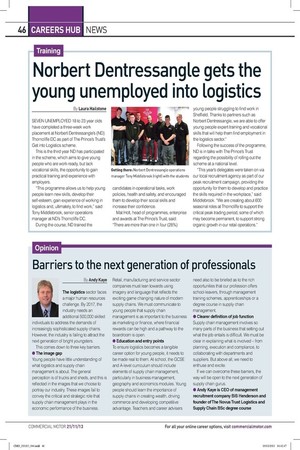Barriers to the next generation of professionals
Page 36

If you've noticed an error in this article please click here to report it so we can fix it.
By Andy Kaye The logistics sector faces a major human resources challenge. By 2017, the industry needs an additional 500,000 skilled
individuals to address the demands of increasingly sophisticated supply chains. However, the industry is failing to attract the next generation of bright youngsters.
This comes down to three key barriers. • The image gap
Young people have little understanding of what logistics and supply chain management is about. The general perception is of trucks and sheds, and this is reflected in the images that we choose to portray our industry. These images fail to convey the critical and strategic role that supply chain management plays in the economic performance of the business.
Retail, manufacturing and service sector companies must lean towards using imagery and language that reflects the exciting game changing nature of modern supply chains. We must communicate to young people that supply chain management is as important to the business as marketing or finance, where financial rewards can be high and a pathway to the boardroom is open. • Education and entry points To ensure logistics becomes a tangible career option for young people, it needs to be made real to them. At school, the GCSE and A-level curriculum should include elements of supply chain management, particularly in business management, geography and economics modules. Young people should learn the importance of supply chains in creating wealth, driving commerce and developing competitive advantage. Teachers and career advisers
need also to be briefed as to the rich opportunities that our profession offers school-leavers, through management training schemes, apprenticeships or a degree course in supply chain management.
• Clearer definition of job function Supply chain management involves so many parts of the business that setting out what the job entails is difficult. We must be clear in explaining what is involved — from planning, execution and compliance, to collaborating with departments and suppliers. But above all, we need to enthuse and excite.
If we can overcome these barriers, the way will be open to the next generation of supply chain gurus. • Andy Kaye is CEO of management recruitment company BiS Henderson and founder of The Novus Trust Logistics and Supply Chain BSc degree course






































